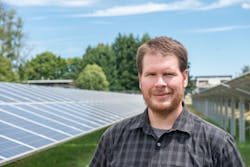Agrivoltaics project under construction at Oregon State University
Oregon State University is partnering with the Oregon Clean Power Cooperative to build the five-acre Solar Harvest project at the OSU North Willamette Research and Extension Center.
Construction on the $1.5 million project is now underway.
The solar project in Aurora, Oregon is financed by members of the Oregon Clean Power Cooperative, which developed the solar array. Additional funding is provided by a grant from Portland General Electric’s Renewable Development Fund and a $800,000 investment by the Roundhouse Foundation.
“The OSU Foundation is grateful to The Roundhouse Foundation for once again making a leadership investment, which has inspired additional generosity,” said Shawn L. Scoville, President and CEO of the OSU Foundation. “This gift in support of OSU’s agrivoltaic farm demonstrates the incredible impact donor support can have on the world’s most pressing challenges, from sustainability to food systems to energy solutions.”
The installation of the solar panels and other equipment is expected to take approximately one month. Electricity from the 326 kW solar system will be available for purchase to Oregon State and community members through a community solar program of the Oregon Clean Power Cooperative.
Once the project is complete, research will begin at the agrivoltaics farm.
Chad Higgins, an associate professor in Oregon State’s College of Agricultural Sciences, is leading the effort to construct the farm. Research by Higgins found that agrivoltaic systems such as these can improve food production, reduce water usage, generate energy and create additional revenue.
However, Higgins pointed out that agrivoltaics research to date has used solar arrays designed only for electricity generation and not for use with growing crops or grazing animals.
The solar array at the North Willamette Research and Extension Center comprises panels that can rotate to a near vertical position for farm equipment to pass. It is designed to facilitate agrivoltaics research.
